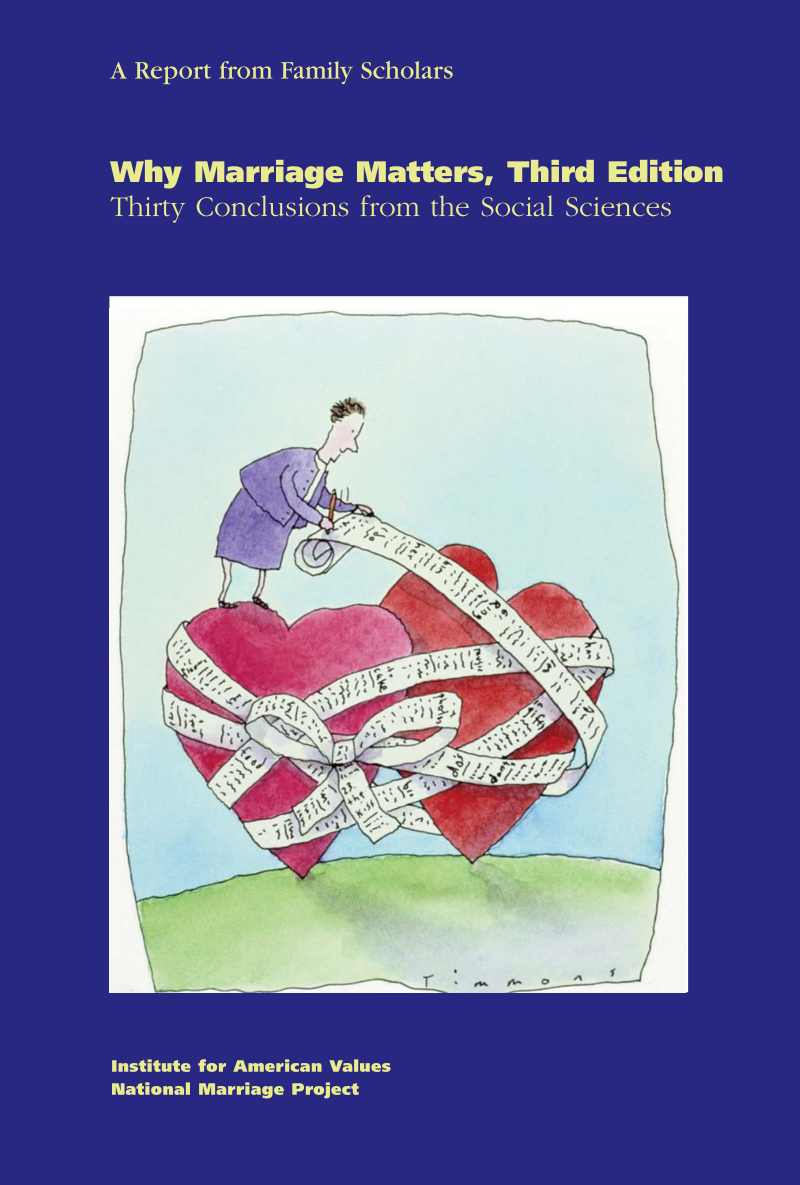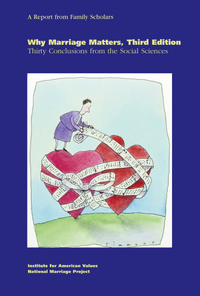Report on social science of marriage.
- Type
- Academic / Technical Report
- Source
- Institute for American Values Non-LDS
- Hearsay
- Secondary
- Reference
Institute for American Values, National Marriage Project, Why Marriage Matters: Thirty Conclusions from the Social Sciences, 3rd ed. (New York: Institute for American Values, 2011), 12-13
- Scribe/Publisher
- Institute for American Values
- People
- Institute for American Values
- Audience
- Reading Public
- Transcription
Family
1. Marriage increases the likelihood that fathers and mothers have good relationships with their children.
2. Children are most likely to enjoy family stability when they are born into a married family.
3. Children are less likely to thrive in complex households.
4. Cohabitation is not the functional equivalent of marriage.
5. Growing up outside an intact marriage increases the likelihood that children will themselves divorce or become unwed parents.
6. Marriage is a virtually universal human institution.
7. Marriage, and a normative commitment to marriage, foster high-quality relationships between adults, as well as between parents and children.
8. Marriage has important biosocial consequences for adults and children.
Economics
9. Divorce and unmarried childbearing increase poverty for both children and mothers, and cohabitation is less likely to alleviate poverty than is marriage.
10. Married couples seem to build more wealth on average than singles or cohabiting couples.
11. Marriage reduces poverty and material hardship for disadvantaged women and their children.
12. Minorities benefit economically from marriage also.
13. Married men earn more money than do single men with similar education and job histories.
14. Parental divorce (or failure to marry) appears to increase children’s risk of school failure.
15. Parental divorce reduces the likelihood that children will graduate from college and achieve high-status jobs.
Physical Health and Longevity
16. Children who live with their own two married parents enjoy better physical health, on average, than do children in other family forms.
17. Parental marriage is associated with a sharply lower risk of infant mortality.
18. Marriage is associated with reduced rates of alcohol and substance abuse for both adults and teens.
19. Married people, especially married men, have longer life expectancies than do otherwise similar singles.
20. Marriage is associated with better health and lower rates of injury, illness, and disability for both men and women.
21. Marriage seems to be associated with better health among minorities and the poor.
Mental Health and Well-Being
22. Children whose parents divorce have higher rates of psychological distress and mental illness.
23. Cohabitation is associated with higher levels of psychological problems among children.
24. Family breakdown appears to increase significantly the risk of suicide.
25. Married mothers have lower rates of depression than do single or cohabiting mothers.
Crime and Domestic Violence
26. Boys raised in non-intact families are more likely to engage in delinquent and criminal behavior.
27. Marriage appears to reduce the risk that adults will be either perpetrators or victims of crime.
28. Married women appear to have a lower risk of experiencing domestic violence than do cohabiting or dating women.
29. A child who is not living with his or her own two married parents is at greater risk of child abuse.
30. There is a growing marriage gap between college-educated Americans and less-educated Americans.
- Citations in Mormonr Qnas
The B. H. Roberts Foundation is not owned by, operated by, or affiliated with the Church of Jesus Christ of Latter-day Saints.


